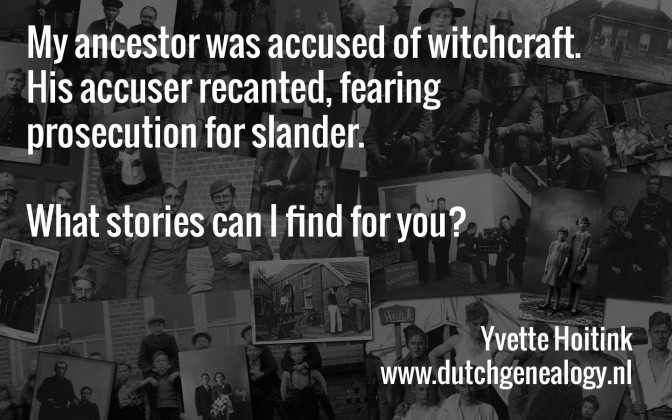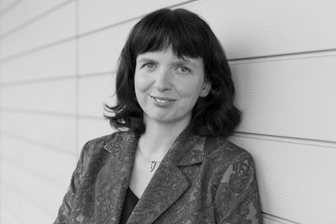In the late medieval period, many unexplained phenomena were attributed to witchcraft. If a healthy child suddenly became ill or a cow would not give milk, the influence of witches was often suspected. Many people were persecuted and burned at the stake, particularly in the Southern Netherlands (current-day Belgium).
By the 1600s, the hunt quieted down. The Enlightenment made people realize that there might well be scientific explanations for things that happened to them. Still, an accusation of witchcraft was a serious thing that needed to be investigated. If the accusation was found to be unfounded, the accuser could be charged with slander. An interesting reversal of positions!

Winterswijk cemetery. Photo by author.
When my ancestors Jan Mensinck and his son Berendt Mensinck were accused of witchcraft by Henrick ten Lutken Ess in 1614, they felt that this tarnished their good name. They notified the court of the charges against them.
On 13 August 1614, Henrick ten Lutken Ess in Ratum, a hamlet near Winterswijk in Gelderland, testified before the court of Bredevoort that he never heard anything about Jan and Berendt Mensinck other than that they were honest, truthful and pious people. If he spoke to the contrary about witchcraft and made other such accusations against them, he denied to have spoken in such a manner, and if he did speak of them in that way, it must have been in drunkenness and haste. After this statement, both parties agreed they were satisfied. If either party would say anything to the contrary, he would forfeit a fine of 50 gold guilders and 50 “molder” of oats.1
The court records do not include more records about this case, so this seems to have been the end of it.
I applaud my ancestors for facing their accuser and forcing him to recant the accusation. I find it fascinating to see how far the attitude towards witchcraft had changed by 1614, to the point that an accused witch could now turn to the court for protection of their reputation, while a hundred years earlier, they might have been burned at the stake. I’m sure the Mensincks were still the talk of the town, but they showed they would stand up for themselves which must have quieted some tongues.
- Court of Manor of Bredevoort, Gelderland, Netherlands, voluntary protocols 1614 fol. 33, 33v, agreement between Henrick ten Lutken Ess and Jan and Berendt Mensinck, 13 August 1614; Rechterlijk Archief Heerlijkheid Bredevoort, record group 3017; Erfgoedcentrum Achterhoek en Liemers, Doetinchem, Netherlands.





Yvette, It is interesting to me that you mention Winterswijk. Both my mother’s family, Neckers, and my Dad’s family, Warnshouse or Warnshuis, came from Winterswijk in the mid 1800’s. They settled in a small farming community, Clymer, NY, Ontario Co., USA. Many people in the village settled there from Winterswijk. We know quite a bit of history on the Neckers side but not too much on the Warnshouse side other than the family owned a farm. Also, they produced ministers and musicians. I am enjoying this Newsletter. Thank you. Denise Warnshouse Morphy
Hi cousin Denise! I am familiar with the Neckes and Warnshouse family. If you search this site for “Warnshuis” you will find some family stories about them.
Hi Yvette: Fascinating story! I, too, am glad they faced down the accuser.
Now, to the reason for my post. Through my late my father (born in Haarlem), there is a possibility that I might be descended from Jan Mensinck. Jan’s son Berendt had a sister named Jenneken Leessinck, who was married to Johan T’Jeinck (Berent Leessinck heeft zijn suster Jenneken Leessinck, gehuwd met Johan T’Jeinck, uitgekocht uit het erf en goed Leessinck in Ratum, d.d. 22 maart 1631 (RABvt 404 f 17). They had a daughter named Geessken (in some records, Gesken).
Today, I spent several hours digging into Gesken’s background. Tentatively, I believe this person was married three times: (1) Berendt Speckinck, (2) Toobe Oostendarp, and (3) Hermen Hermelinck. I am descended through Toobe Oostendarp.
For your convenience, I posted my initial findings here on a forum. When you have time, please take a look, and let me know if you believe I am on the right track: https://www.stamboomforum.nl/subfora/2/2/91920/0/seeking_origins_of_gesken_tijenck_geessken_tjeinck_of_17th_century_winterswijk
You may have to copy and paste the hyperlink.
Thanks and hope to hear from you.
Kindest regards,
Steve Barnhoorn
Honeoye, New York
USA